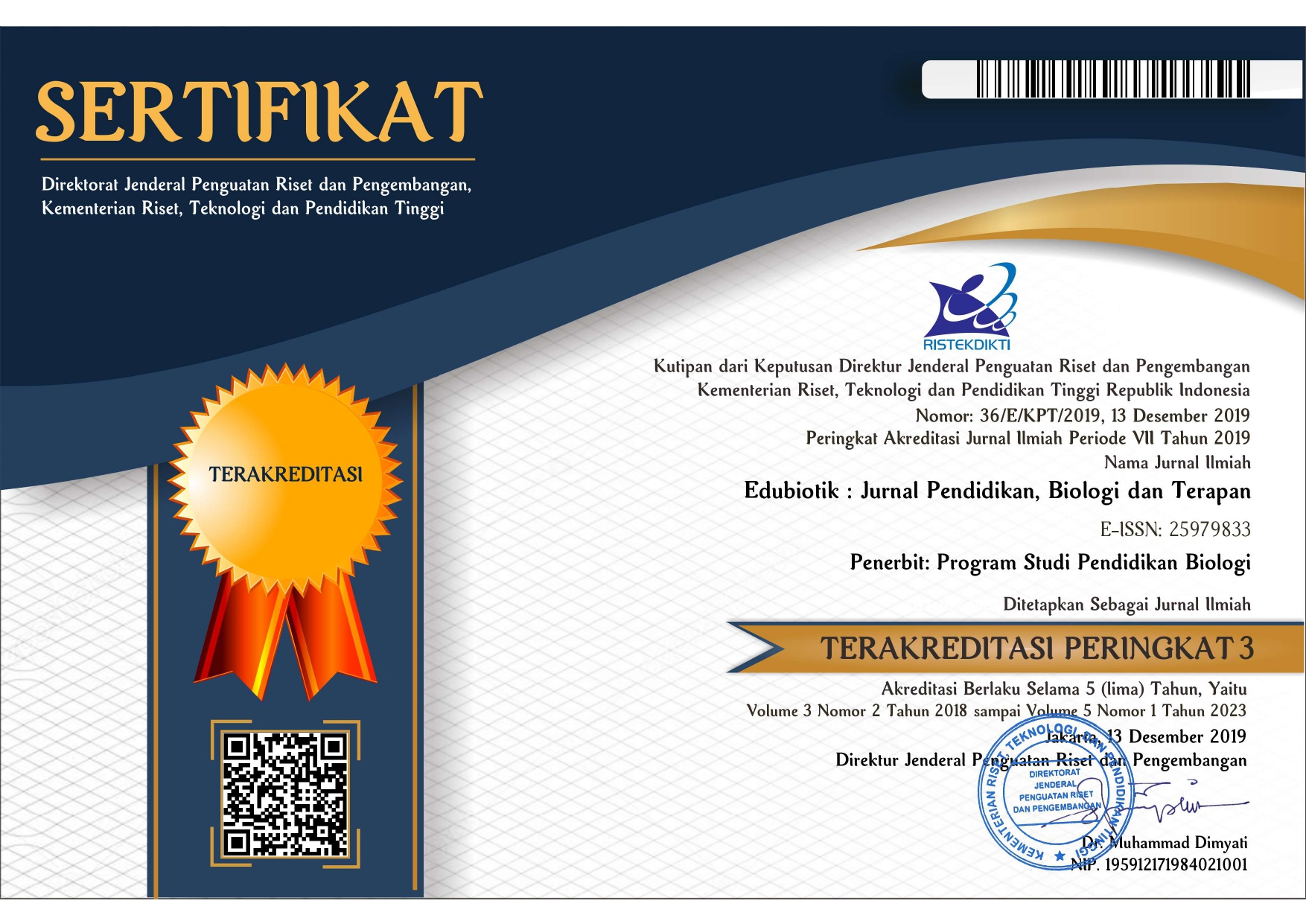Bacteria Pseudomonas taiwanensis as a decomposing agent of peat fiber
Abstract
Efforts are needed to accelerate the decomposition of peat fiber to reduce the fiber content through bioaugmentation using Pseudomonas taiwanensis bacteria so that it can reduce the high-water content of peat fiber. The research aimed to determine the effect of adding Pseudomonas taiwanensis bacteria on the decomposition of peat fiber. This research is a laboratory experimental research. The research sampling location was in Bereng Bengkel Village, Palangkaraya. The parameters observed included fiber content, fiber size distribution, and peat fiber decomposition speed following the Peat Testing Manual. The research instrument was an observation sheet for fiber content, size distribution, and peat fiber decomposition speed. Research data was analyzed using descriptive statistical analysis. The results showed that adding 15% Pseudomonas taiwanensis bacteria with a curing period of 28 days in fibrous peat resulted in the highest reduction in fiber content, from the initial condition of 61.14% to 12.33%. This variation also shows a decrease in coarse and medium fiber content and a significant increase in fine fiber content. The decomposition rate for this variation shows good consistency. The conclusion was that adding 15% Pseudomonas taiwanensis bacteria with a curing period of 28 days showed optimal results in accelerating the decomposition of peat fiber through the bioaugmentation method.
References
Bay, Y. P., Yulianti, N., Suparno, S., Adji, F. F., Damanik, Z., & Sustiyah, S. (2021). Sifat fisik gambut pedalaman pada laboratorium alam hutan gambut Sebangau, Kalimantan Tengah. Jurnal Ilmu Lingkungan, 15(2), 216-233. https://doi.org/10.31258/jil.15.2.p.216-233
Chen, M., Gowthaman, S., Nakashima, K., Komatsu, S., & Kawasaki, S. (2021). High water content peat soil improved by MICP technique with fiber-reinforcement. International Conference on GEOMATE, Kyoto, Japan 16–21. http://repo.lib.jfn.ac.lk/ujrr/handle/123456789/4351
Darma, A. T., Walida, H., Saragih, S. H. Y., & Rizal, K. (2022). The analysis of peat soil biological characteristics after being incubated using vermicompost from a mixture of chicken dung, banana hump, and tofu waste. JURNAL AGRONOMI TANAMAN TROPIKA (JUATIKA), 4(2), 207–215. https://doi.org/10.36378/juatika.v4i2.2233
Devangsari, I. M., Nurudin, M., Sartohadi, J., & Karmila, Y. A. (2022). Characteristics of peat functional group in Padang Island, Indonesia. IOP Conference Series: Earth and Environmental Science, 1005(2022) 012022, 1-9. https://doi.org/10.1088/1755-1315/1005/1/012022
Fidiastuti, H. R., & Suarsini, E. (2017). Potensi bakteri indigen dalam mendegradasi limbah cair pabrik kulit secara in vitro. Bioeksperimen, 3(1), 1-10. https://doi.org/10.23917/bioeksperimen.v3i1.3665
Gofar, N., & Sutejo, Y. (2007). Long term compression behavior of fibrous peat. Malaysian Journal of Civil Engineering, 19(2), 104–116. https://journals.utm.my/mjce/article/view/15751
He, T., Ye, Q., Sun, Q., Cai, X., Ni, J., Li, Z., & Xie, D. (2018). Removal of nitrate in simulated water at low temperature by a novel psychrotrophic and aerobic bacterium, Pseudomonas taiwanensis strain j. BioMed Research International, 4984087, 1-9. https://doi.org/10.1155/2018/4984087
Hibbing, M. E., Fuqua, C., Parsek, M. R., & Peterson, S. B. (2010). Bacterial competition: Surviving and thriving in the microbial jungle. Nature Reviews Microbiology, 8, 15–25 (2010). https://doi.org/10.1038/nrmicro2259
Hikmatullah, & Sukarman. (2014). Physical and chemical properties of cultivated peat soils in four trial sites of ICCTF in Kalimantan and Sumatra, Indonesia. Journal of Tropical Soils, 19(3), 131–141. http://dx.doi.org/10.5400/jts.2014.v19i3.131-141
Hu, B. L., Rush, D., Biezen, E. Van Der, Zheng, P., Mullekom, M. Van, Schouten, S., Sinninghe Damsté, J. S., Smolders, A. J. P., Jetten, M. S. M., & Kartal, B. (2011). New anaerobic, ammonium-oxidizing community enriched from peat soil. Applied and Environmental Microbiology, 77(3), 966–971. https://doi.org/10.1128/AEM.02402-10
Ismail, A. G., Mustofa, A., Dwicahyani, A., Ridlo, M. M., & Sambowo, A. (2017). Pengaruh beton daur ulang dan bahan tambah fly ash terhadap kuat tekan dan kuat lentur beton struktural ramah lingkungan. Jurnal Riset Rekayasa Sipil, 1(1), 59–63. https://doi.org/10.20961/jrrs.v1i1.14722
Johari, N. N., Bakar, I., Razali, S. N. M., & Wahab, N. (2016). Fiber effects on compressibility of peat. IOP Conference Series: Materials Science and Engineering, 136(1), 1–9. https://doi.org/10.1088/1757-899X/136/1/012036
Kolay, P. K., & Taib, S. N. L. (2018). Physical and geotechnical properties of tropical peat and its stabilization. In Peat, 93–105. https://doi.org/10.5772/intechopen.74173
Kumar, N., Chaturvedi, S., & Khurana, S. M. P. (2022). Survival and thriving behavior of bacteria in microbial jungle. Microbial Resource Technologies for Sustainable Development, 1–21. https://doi.org/10.1016/B978-0-323-90590-9.00011-0
Li, Z. S., Rahayu, W., Souli, H., Soepandji., B. S., & Fleureau, J. M. (2022). Compressibility and shear strength of a tropical fibrous peat. Géotechnique Letters, 12(2), 139-147. https://doi.org/10.1680/jgele.21.00154
Ma’ruf, M. A., Yulianto, F. E., Wardani, M. K., Iswinarti, & Firmansyah, Y. K. (2022). Utilization of lime and rice husk ash for peat soil stabilization in different water content condition. IOP Conference Series: Earth and Environmental Science, 999(012028), 1-6. https://doi.org/10.1088/1755-1315/999/1/012028
Masganti, Anwar, K., & Susanti, M. A. (2017). Potensi dan pemanfaatan lahan gambut dangkal untuk pertanian. Jurnal Sumberdaya Lahan, 11(1), 43–52. https://www.neliti.com/publications/223343/
Medaura, M. C., Guivernau, M., Moreno-Ventas, X., Prenafeta-Boldú, F. X., & Viñas, M. (2021). Bioaugmentation of native fungi, an efficient strategy for the bioremediation of an aged industrially polluted soil with heavy hydrocarbons. Frontiers in Microbiology, 12(626436). https://doi.org/10.3389/fmicb.2021.626436
Mochtar, N. E., & Yulianto, F. E. (2014). Pengaruh usia stabilisasi pada tanah gambut berserat yang distabilisasi dengan campuran CaCO3 dan pozolan. Jurnal Teknik Sipil, 21(1), 57–64. https://doi.org/10.5614/jts.2014.21.1.6
Ngapiyatun, S., Rahman, A., Aziza, H., & Winarni, B. (2020). Pemanfaatan limbah sampah kota sebagai kompos. Buletin Loupe , 16(02), 1–6. https://doi.org/10.51967/buletinloupe.v16i02.222
Palamba, P., Ramadhan, M. L., Pamitran, A. S., Prayogo, G., Kosasih, E. A., & Nugroho, Y. S. (2018). Drying kinetics of Indonesian peat. International Journal of Technology, 9(5), 1006–1014. https://doi.org/10.14716/ijtech.v9i5.805
Prativi, A., Mochtar, N. E., & Zulaika, D. E. (2018). Peat soil stabilization by adding solution of endogenous aerobic decomposer bacteria consortium. Proceeding 12th International Conference on Building Design, Materials, Civil and Transportation Engineering (BDMCTE-18), Bali, Indonesia, 78–83. https://www.dirpub.org/images/proceedings_pdf/DIR0118404.pdf
Ramdhan, M. (2018). Analisis persepsi masyarakat terhadap kebijakan restorasi lahan gambut di Kalimantan Tengah. Jurnal Risalah Kebijakan Pertanian Dan Lingkungan, 4(1), 60-72. https://journal.ipb.ac.id/index.php/jkebijakan/article/view/20066
Rismantojo, E., & Ningsih, N. N. (2021). Pengaruh penambahan mikroorganisme terhadap sifat fisik dan kuat geser tanah gambut Palembang. Jurnal Teknik Sipil, 28(3), 269–280. https://doi.org/10.5614/jts.2021.28.3.4
Saida, N. A., George, A. D., & Mohamad, H. M. (2023). A review on experimental investigations and geotechnical characteristic of peat soil stabilization. International Journal of Advanced Research in Engineering Innovation, 5(1), 1–19. https://doi.org/10.55057/ijarei.2023.5.1.1
Santi, I. N., Hayata, H., & Bangun, B. (2022). Characteristics of peat with different depths in supporting growth and productivity of oil palm. Journal of Tropical Soils, 28(1), 17. https://doi.org/10.5400/jts.2023.v28i1.17-22
Sari, N. P., Rinaldi, & Rodhiyah, Z. (2021). Pengaruh perbedaan tinggi tumpukan kompos terhadap jumlah bakteri Escherichia coli dan Salmonella sp. pada kompos sampah organik pasar dan limbah padat rumah potong hewan. Jurnal Engineering Universitas Jambi, 3(1), 44–55. https://doi.org/10.22437/jurnalengineering.v3i1.12206
Stevani, A., & Makarim, C. A. (2021). Analisis perbandingan penurunan fondasi dangkal di tanah gambut dengan stabilisas kapur dan abu sekam padi. JMTS: Jurnal Mitra Teknik Sipil, 4(1), 233–248. https://doi.org/10.24912/jmts.v0i0.11099
Pradana, M. S, & Rohmah, A. M. (2018). Pemodelan kadar air pada sifat fisik stabilisasi tanah gambut. Journal of Mathematics and Mathematics Education (JMME), 8(1), 56–67. https://doi.org/10.20961/jmme.v8i1.25826
Takada, M., Shimada, S., & Takahashi, H. (2016). Tropical peat formation. Tropical Peatland Ecosystems (pp. 127–135). Springer Japan. https://doi.org/10.1007/978-4-431-55681-7_8
Wahab, A., Embong, Z., Hasan, M., Musa, H., Zaman, Q. U. Z., & Ullah, H. (2020). Peat soil engineering and mechanical properties improvement under the effect of eks technique at parit kuari, Batu Pahat, Johor, West Malaysia. Bulletin of the Geological Society of Malaysia, 70, 133–138. https://doi.org/10.7186/bgsm70202011
Wang, L. T., Tai, C. J., Wu, Y. C., Chen, Y. B., Lee, F. L., & Wang, S. L. (2010). Pseudomonas taiwanensis Sp. Nov., isolated from soil. International Journal of Systematic and Evolutionary Microbiology, 60(9), 2094–2098. https://doi.org/10.1099/ijs.0.014779-0
Waruwu, A., Deni Susanti, R., Sanjaya Sihombing, H., Yogi Purba, T., Kunci, K.-K., Bambu, G., Beton, T., & Sistem Perkuatan, S. (2020). Pengaruh susunan tiang dengan grid bambu pada tanah gambut terhadap lendutan. Prosiding Seminar Nasioanl Teknik (SEMNASTEK) Universitas Islam Sumatera Utara, 9–15. https://jurnal.uisu.ac.id/index.php/semnastek/article/view/2983
Yogyanta, D. A., Mochtar, N. E., & Zulaika, E. (2019). Acceleration of decomposition process by lignocellulolytic bacteria and its effect on the physical and engineering properties of Kalimantan fibrous peat. Proceedings of the Third International Conference on Sustainable Innovation 2019-Technology and Engineering (IcoSITE 2019), 187, 35-39. https://doi.org/10.2991/icosite-19.2019.7
Yulianto, F. E., Mochtar, N. E., & Ma’ruf Afif, M. (2022). Physical and engineering properties of peat soil stabilized with the admixture of CaCO3+rice husk ash due to water infiltration from surrounding ares. Journal of Applied Engineering Science, 20(1), 276–284. https://doi.org/10.5937/jaes0-32003
Zebua, H. F. (2022). Analisa penurunan akibat beban timbunan pada tanah gambut dengan perkuatan. Jurnal Ilmiah Desain & Konstruksi, 21(1), 50–64. https://doi.org/10.35760/dk.2022.v21i1.5188
Zulaika, E., Solikhah, F., Utomo, M. A. P., Endah, N., & Assavalapsakul, W. (2022). Cellulose degrading bacteria isolated from Palangkaraya, Central Kalimantan, Indonesia as peat fiber decomposer to accelerate peat soil compression. Biodiversitas: Journal of Biologycal Diversity, 23(3), 1648–1654. https://doi.org/10.13057/biodiv/d230356





.png)
2.png)

1.jpg)


